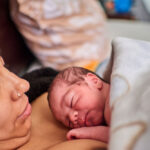Passport to pregnancy: Traditions from around the world
There are almost 7,000 recognized languages throughout the world—and each […]
There are almost 7,000 recognized languages throughout the world—and each and every one of them has a word to describe dear ol’ mom. Across many of these languages, the quests toward motherhood are as different as the cultures that speak them. Whether you’re looking forward to being beckoned as maman en Français, madre en Español or simply mama in English, your path to parenthood is certain to be distinctly unique.
Mommy-to-be taboos
Internationally, moms are bound by one unified desire: to have a safe, easy pregnancy. However, the list of precautions one follows varies significantly across borders.
Bali: You won’t catch any Balinese mommies- to-be eating octopus—doing so allegedly brings about difficult deliveries.
Bolivia: No hand-knit booties for Bolivian babies! Knitting while pregnant is believed to cause the umbilical cord to wrap around the baby’s neck.
China: For the duration of their pregnancies, Chinese women make a conscious effort to steer clear of evil spirits, funerals and sex.
Guatemala: Women in this country, particularly those of Mayan descent, may remain at home throughout their entire nine months because they fear any influential exposure to illness, evil spirits or even the ill will of others.
Inuit: Inflating balloons or blowing bubbles with gum is avoided during pregnancy to prevent premature rupturing of the membranes.
Mexico: Mexican women are urged to only bathe in warm water—water that is too hot is thought to lead to circulatory problems, and water that’s too cold could make the pelvis rigid and lead to a long, hard birth.
Dedication to incubation
Giving up sushi-and-sake date night may be a little tough for some American mamas, but rest assured that pregnant peers around the globe face gestational adjustments of their own.
In China, the personality and disposition of an unborn child is thought to be strongly influenced by the state of his mother’s mind and body while expecting. For this reason, Chinese women are strongly urged to control their thoughts and actions —meaning no gossiping, no temper tantrums and no hard physical labor while baby is incubating.
For a woman in Ethiopia, pregnancy is viewed as extremely natural. So much so, in fact, that she experiences little to no changes in her day-to-day life during the majority of her pregnancy.
Pregnant women in Polynesia are nurtured and pampered by the entire community throughout the duration of their joyous gestational period. In addition to their every whim being tended to, a midwife visits regularly to administer much-deserved massages.
The presence of presents
Baby showers are all the rage in the U.S., and for the most part, just about any gift goes. (Breast pads? Diaper rash cream? Bring ’em on!) However, other cultures have different ideas about what to give a new family and when to present it.
China: Gift-giving before birth is considered very unlucky in Chinese culture—not to mention you could be stepping on grandma’s toes! The mother-to-be’s own mother is typically responsible for the new baby’s entire layette. A month before birth, the maternal grandmother sends a gift of clothing for the newborn to hasten delivery, then three days after the baby arrives, she visits with the remainder of her grandchild’s wardrobe and gear.
Egypt: Seven days after baby arrives, Egyptian parents throw a sebou to celebrate the birth. During this event, the new baby receives his or her name, and religious gifts and jewelry are brought for the baby and new mom.
Greece: For Greek families, the birth of a child brings great joy to the entire community. Several days after birth, a newborn may receive customary gifts from her family and friends, including silver and gold coins or special stones to help ward off the “evil eye.”
Japan: Although very close family members may get to welcome a new baby at the oshichia—a naming ceremony that takes place seven days after birth—most family and friends have to wait a couple months to share their congratulations. Friends and family don’t meet the new addition or bestow gifts of money on the new parents until mom and baby have had ample time to bond and heal.
Tibet: Three to four days after birth, family members from near and far gather to celebrate the pang-sai, or cleansing of the baby, for his or her journey into life. Gifts of food and clothing are presented to signify wishes for an abundant life; the child is then given a name by the most respected person in attendance.
Pain management
Because epidurals haven’t always been—and still aren’t always—an option, foreign cultures have developed some seriously stunning ways for mamas to keep their calm during labor.
China: Since the ancient Chinese view childbearing as an age-old women’s vocation, custom dictates that fear and apprehension be abolished from the process. To help with this, women often drink a strong herbal potion to ease the pains of labor.
Guatemala: Guatemalan women believe speedy delivery can be induced by drinking a liquid created by boiling a purple onion in beer.
Korea: Stoic by tradition, Korean women often refuse pain management in favor of quietly making their way through labor and delivery.
Morocco: During birth, the gabla, or midwife, massages the pregnant woman’s stomach and vulva with olive oil to make the baby’s passage easier. She also prepares a variety of herbal infusions from mint, thyme, cloves and cinnamon to ease the pain of contractions.
Native America: Early American-Indians used a mixture of blue cohosh root and water to speed up delivery.
Niger: Muslim tradition allows only a woman’s husband to touch her genitals, so midwives in this African nation facilitate labor by offering the mom-to-be herbal drinks and sprinkling herbs over her abdomen.
Sri Lanka: This country is heavily influenced by Buddhism, which supports the idea that suffering during birth is linked to sins committed during previous lives; thus, it’s a source of pride for a woman to go through childbirth without expressing her pain.
Taiwan: It’s respectful to not cry out when bringing a baby into the world, so as not to disturb the other inhabitants of the village.
Togo: Keeping quiet during birth ensures you won’t attract the attention of any evil spirits.
Vietnam: For Vietnamese women, silence is golden. In fact, their emotions can be so bottled up that it’s not uncommon for the walls of the perineum to tear from stress during birth.
Rite of passage rituals
In many cultures, bringing a baby into the world is a sacred event—one that, when filled with certain actions and rituals, can help protect a new baby’s life. Unlike here in the U.S., where we generally dispose of the umbilical cord and placenta, many cultures believe these “leftovers” can influence a baby’s future.
Cambodia: After birth, the mother’s placenta is carefully wrapped in a banana tree leaf, placed beside the newborn for three days, then buried.
India: To symbolize the “openness” of the womb during birth, pregnant Indian women leave their hair down, remove any jewelry and leave all doors in the house open. After birth, the umbilical cord is gently placed around the child’s neck.
Japan: The umbilical cord is cleaned and placed in a kotobuki bako—a keepsake box that is made to protect the precious memento and ensure a positive mother-child relationship down the road.
Mali: The placenta is considered a very powerful force that can affect a new baby’s mood or make him ill. To avoid any negative repercussions, the placenta is washed, dried and placed in a basket to be buried by the father.
Mexico: During birth, all of the doors and windows are closed to protect mother and baby from evil forces that could make their way in during such an intimate, exposed process.
Morocco: Much like Indian women, Moroccan mamas steer clear of any restricting forces by leaving their heads uncovered, their hair down and their belts unfastened to provide a smooth, open passage for their wee ones.
What’s in a name?
Naming a baby isn’t always about thumbing through a book and picking the most pleasant-sounding moniker. For some, the process is highly complex and filled with social and religious rules and taboos.
Africa: Different areas of Africa use different techniques, but all tribes take great pride in naming their newest additions. The Zulu choose names that are relevant at the time of a child’s birth, so the name may reflect the social circumstances and time frame in which the baby was born. The Yoruba in Nigeria choose names that, in the future, will lend information about a child’s background.
China: Chinese babies receive their official names after birth—and many times, they’ll be given up to four more throughout their lives: one for childhood, one for school, one for adulthood and another upon death.
Greece: Greek names are often chosen to honor earlier generations. Customarily, a child’s first name is after his or her grandparents, while the middle name is borrowed directly from the parents.
Hawaii: Hawaiian names are unique for each new child, and have very deep family meanings that are thought to be extraordinarily powerful. Most of these symbolic names are unisex, as well as somewhat complex so as to avoid attracting evil forces.
Native America: The Inyana tribe so respects their elders that the maternal grandmother chooses a newborn’s first name and the paternal grandmother offers the middle.
Philippines: Children are rarely named at birth for fear that an elder or ancestor will take them into the next life. Children are given generic or unattractive nicknames until they are healthy and can be given proper names. They may receive up to 10 names during a lifetime.
Saudi Arabia: In accordance with Muslim tradition, Saudi babies are given their names seven days after birth in an aqiqah ceremony. Relatives and friends gather and watch as the infant’s head is shaved and his hair placed on a scale with silver or gold that is then given to the poor.
Switzerland: In this country, it’s considered unlucky to share your child’s chosen name before he or she arrives.
Postnatal practices
From postbirth healing and baby bonding to maternity (and paternity!) leave, the world works on different timelines.
Bali: The first few months after birth are dedicated to healing—and holding. Babies in Bali don’t touch the floor for the first 105 days after birth, but instead are held continuously by their mothers and other close family members.
Bulgaria: Bulgarian mamas are, by far, the most pampered ladies on the leave scale; not only do employed moms-to-be receive 45 days of fully paid leave before their babies arrive, they receive two full years of paid leave once they’ve given birth. Oh, and they also have the option of tacking on an additional year of unpaid leave before they return to their jobs—which will patiently await their return for 3+ years!
Canada: In addition to 15 weeks of maternity leave for a new mom, there are another 35 weeks of paid leave to be divided between mom and dad so that both have plenty of time for bonding with baby.
China: During a ritual referred to as “sitting the month,” new moms take an entire month off from their duties to simply stay in bed, heal and connect with their newborns.
Cuba: Cuban mommies get six months of maternity leave to take care of themselves and their wee ones before returning to their daily duties.
Guatemala: As a part of la cuarantena, family members and close friends take over household duties while a new mama goes through 40 days of healing and mother-infant bonding.
United Kingdom: On the other side of the pond, British mums receive 39 weeks of maternity leave paid in full, and an additional 12 weeks with partial pay.








